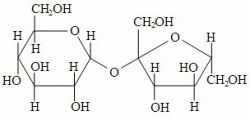 Sucrose is a chemical substance extracted from sugar cane, sugar beet and some fruits, which can be used in the production of sugar. "table sugar" and other sweet products, such as jellies, syrups and sweets.
Sucrose is a chemical substance extracted from sugar cane, sugar beet and some fruits, which can be used in the production of sugar. "table sugar" and other sweet products, such as jellies, syrups and sweets.
Sucrose is classified as a disaccharide, and its chemical formula is C12H22O11.
Molar mass of sucrose: 342.24 g mol-1
Sucrose is formed through the condensation of a fructose and a glucose molecule as a result of photosynthesis produced by the plant.
Among the main characteristics of sucrose is its sweet taste, your appearance of white crystals and the ability to dissolve in water.
Sucrose, Glucose and Fructose
While sucrose is classified as a disaccharide carbohydrate, glucose and fructose belong to the group of monosaccharides, as they do not undergo hydrolysis (breakdown of molecules through the addition of water).
When sucrose undergoes hydrolysis, however, the opposite process to its formation occurs, that is, two monosaccharides are formed in its place: glucose and fructose.
Glucose is usually present in fruits, pasta and in the blood of mammals. Fructose, on the other hand, is only common in fruits and honey.
It is necessary to be aware of the ideal amount of intake of each of these substances, as they can be harmful to health if overdone, as well as their scarcity in the body can also represent a problem.
Learn more about meaning of glucose.

